Physical Address
304 North Cardinal St.
Dorchester Center, MA 02124
Physical Address
304 North Cardinal St.
Dorchester Center, MA 02124

Outstanding campfire storytelling requires mastering ten crucial techniques that transform ordinary tales into spine-tingling adventures your audience will never forget.
You’ve gathered wood, pitched your tent, and watched the sun disappear behind the trees. Now everyone’s sitting around the crackling fire, marshmallows roasting, waiting for something more than small talk to fill the evening air. This is your moment to transform an ordinary camping night into something unforgettable. But there’s a difference between rambling through a story and truly mesmerizing your audience. The techniques that separate amateur storytellers from masters aren’t complicated—they’re just rarely discussed.
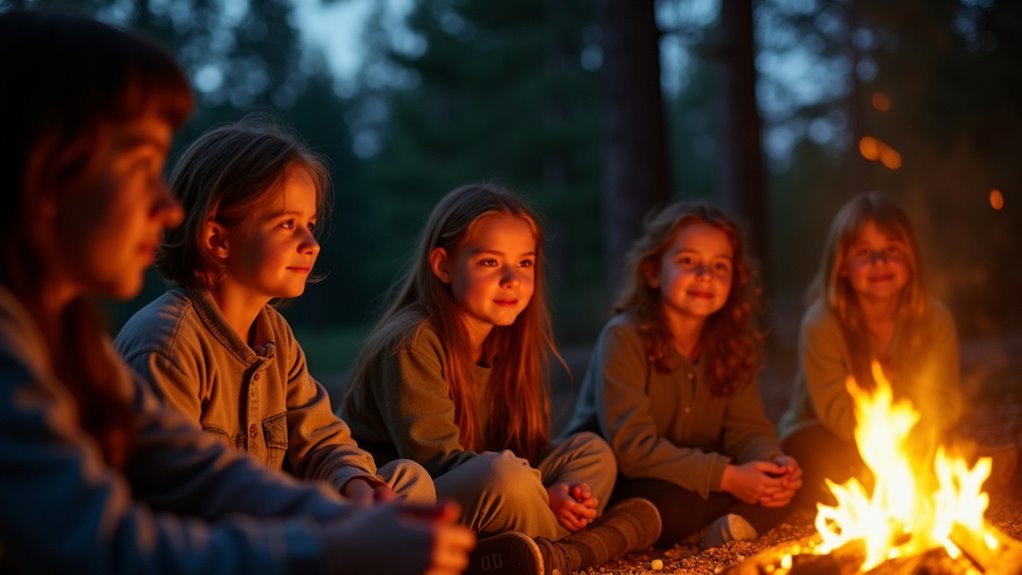
When you’re selecting stories for your campfire audience, consider who’s listening and where you are. A ghost story that thrills teenagers might terrify young children, while adults often appreciate tales with deeper themes or personal anecdotes. Match your content to their comfort level and interests.
Your setting matters too. Stories about local legends work brilliantly when you’re camping near the actual location. Urban legends feel more authentic in wilderness settings, while family stories shine during reunions or intimate gatherings.
Consider the time and mood as well. Light-hearted tales work perfectly as the sun sets, but spine-tingling stories become more effective as darkness deepens. You’ll also want shorter stories when people seem restless and longer, more elaborate tales when everyone’s settled in comfortably.
Just as you might choose chic accessories to complement your winter adventures, selecting the right story accessories – like props, sound effects, or interactive elements – can enhance your storytelling and make the experience more memorable for your audience.
Your voice becomes the most powerful tool in your storytelling arsenal once you learn to control its pitch, pace, and volume. Drop to a whisper during suspenseful moments—everyone will lean in closer. Raise your voice for dramatic revelations, then pause for effect. Speed up during action sequences to build excitement, but slow down when describing eerie atmospheres.
Change your pitch for different characters. Make villains sound menacing with deeper tones, while children’s voices get higher inflections. Don’t forget strategic pauses—they’re as important as words themselves. Let silence hang after cliffhangers or shocking twists.
Practice varying your rhythm. Monotone delivery kills even the best stories. Use your natural speaking voice as home base, then venture into different vocal territories to bring characters and scenes alive around that flickering campfire.
Just like deciding whether to rent or buy a boat for occasional fishing trips, consider how often you’ll tell stories before investing heavily in advanced vocal techniques.
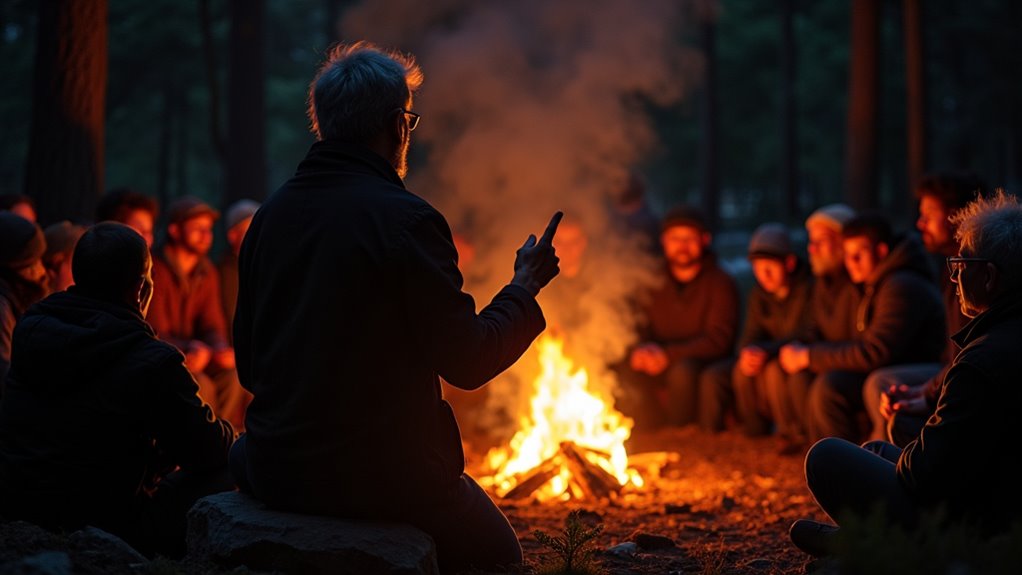
Among all the vocal techniques at your disposal, the strategic pause stands as your secret weapon for maximum impact. When you reach a story’s climactic moment, stop speaking entirely. Let silence hang in the air for three to five seconds while you scan your audience’s faces.
You’ll watch their anticipation build as they lean forward, waiting for what comes next.
Time your pauses right before revealing crucial plot twists, jump scares, or character discoveries. Don’t overuse them—save pauses for your story’s most powerful moments.
The flickering campfire and surrounding darkness naturally amplify tension during these quiet beats. Your audience’s imagination fills the silence, often creating more suspense than words alone could achieve.
Master this technique, and you’ll transform good stories into unforgettable experiences. After your camping adventure, remember that proper gear storage during winter months will ensure your equipment stays in excellent condition for next season’s storytelling sessions.
Every great campfire storyteller understands that words alone won’t captivate an audience—you need your entire body to bring stories to life. Use your hands to show size, shape, and movement. Spread your arms wide for enormous creatures or pinch your fingers for tiny details. Lean forward during intense moments to draw listeners closer, then step back when revealing shocking twists.
Your facial expressions should match your story’s mood. Widen your eyes for surprise, furrow your brow for confusion, or flash a mischievous grin for comedic moments. Point into the darkness beyond the fire when describing mysterious sounds or approaching danger.
Don’t overdo it—subtle gestures often work better than dramatic flourishes. Let your movements feel natural and complement your words rather than distract from them. After an evening of animated storytelling, you’ll appreciate having a comfortable camping air bed to rest on for a good night’s sleep under the stars.
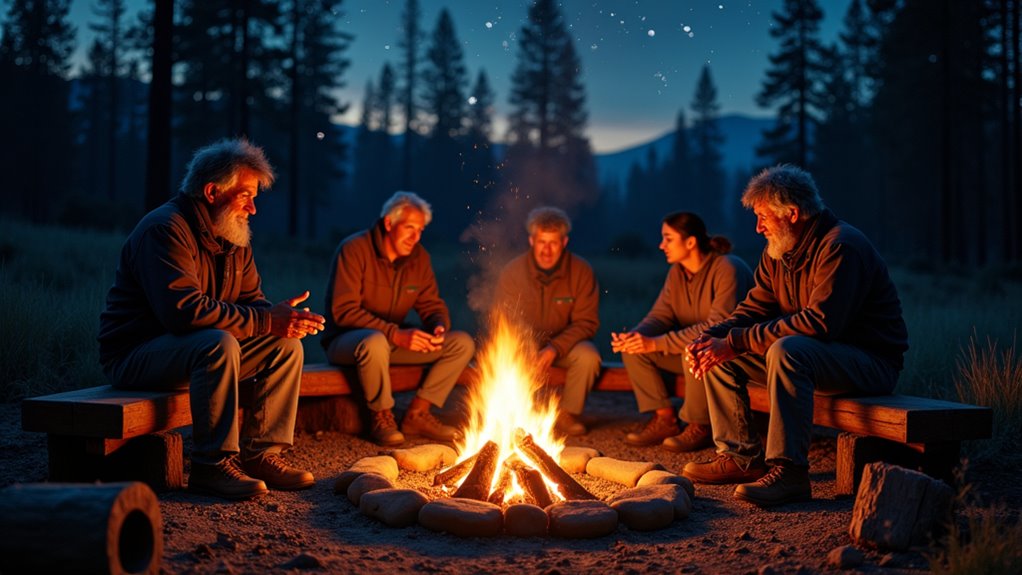
While your gestures help bring stories to life, the words you choose paint the picture your audience will see in their minds.
Transform simple settings into vivid landscapes by engaging all five senses. Instead of saying “it was dark,” describe how “shadows swallowed the moonless forest, leaving only the crunch of dead leaves underfoot.” Replace generic descriptions with specific details that create atmosphere.
Use concrete imagery rather than vague statements. Don’t just mention a house—describe the “weathered Victorian mansion with peeling yellow paint and shutters hanging askew.” Layer in sensory details: the musty smell of old wood, the groan of floorboards, the icy touch of a doorknob. These precise descriptive elements transport listeners directly into your story’s world.
When sharing tales from your adventures, incorporate details about cycling worldwide experiences—the rhythm of pedals against mountain trails, the scent of pine around remote campsites, or the sound of tent fabric flapping in desert winds.
Where you position yourself around the campfire can make or break your storytelling performance. Your physical placement affects how well your audience can see and hear you, directly impacting their engagement with your tale.
Choose a spot where the firelight illuminates your face without creating harsh shadows. You’ll want everyone to see your expressions clearly while maintaining good eye contact with your listeners.
Consider these positioning strategies:
Understanding basic camping terminology will also help you communicate more effectively with your audience when referencing equipment or campsite features during your stories.
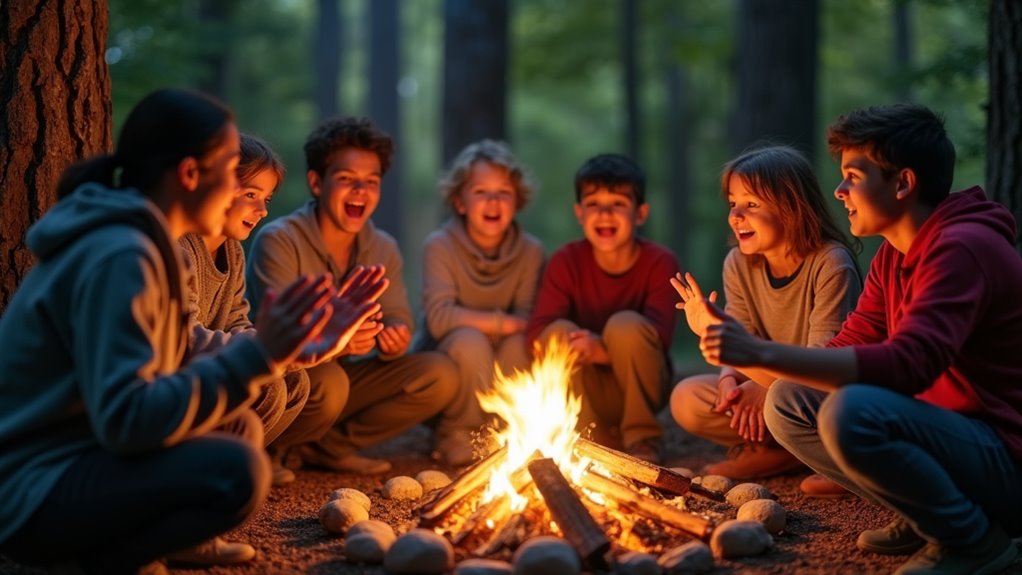
Once you’ve found your perfect spot around the fire, you can turn a good story into an unforgettable experience by getting your audience involved. Ask questions that pull listeners into the narrative: “What would you do if you heard that strange noise?” or “Can you guess what happened next?” Encourage them to make sound effects—howling wind, creaking doors, or footsteps on gravel.
Have them repeat key phrases or chants that build suspense. Use props like flashlights, sticks, or stones to enhance dramatic moments. Create moments where everyone must stay perfectly silent to “listen for danger.” These interactive elements transform passive listeners into active participants, making your campfire story memorable long after the embers fade. Whether you’re on a bushwalking adventure or at a local campground, these storytelling techniques work perfectly in Australia’s diverse outdoor settings.
After you’ve drawn your audience into the story, mastering the rhythm becomes your secret weapon for maximum impact. Pacing controls emotions, builds tension, and keeps listeners hooked around the flickering flames.
Think of your story like a musical composition—it needs crescendos and quiet moments to captivate effectively:
Like a symphony, your campfire story needs both thunderous crescendos and whispered interludes to truly mesmerize your audience.
Practice controlling your delivery speed beforehand. Rush through exposition, then deliberately crawl through spine-tingling revelations.
This intentional pacing transforms ordinary tales into unforgettable campfire experiences.
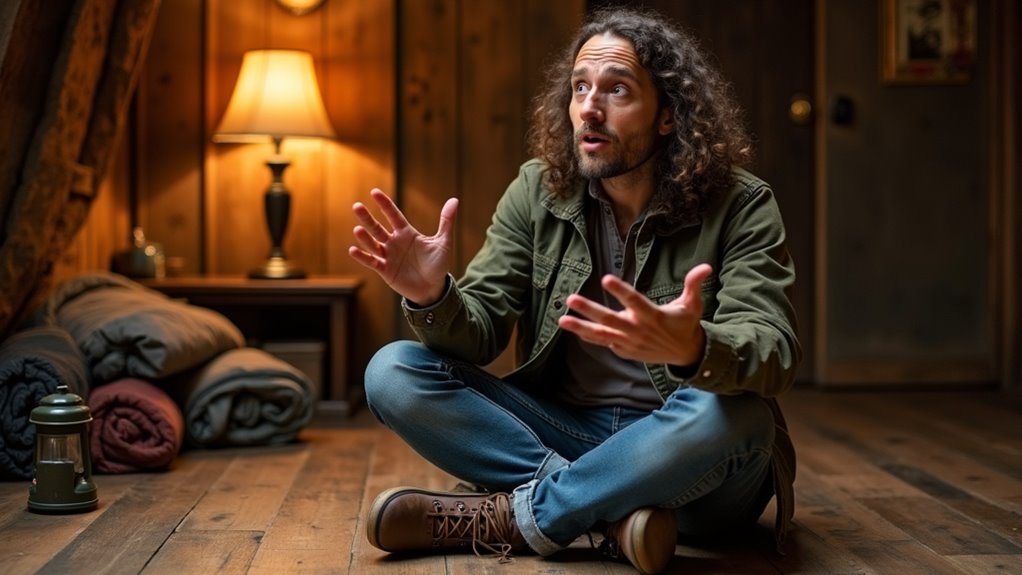
Mastering pacing techniques means nothing if you stumble through your story when the moment arrives. You need to rehearse your tales beforehand to deliver them smoothly around the fire.
Start by selecting three to five stories you’re comfortable telling. Practice them out loud, not just in your head. Record yourself or tell them to family members for feedback. Focus on your voice projection, dramatic pauses, and character voices.
Time your stories to guarantee they’re appropriate lengths. Short tales work better for restless audiences, while longer stories suit engaged listeners.
Run through your opening lines until they’re second nature. A confident start sets the tone for everything that follows. Don’t memorize word-for-word, but know your key plot points and transition cold.
Whether you’re planning to share stories on famous hiking trails like Scotland’s West Highland Way or around your local campground, thorough preparation ensures your audience stays captivated throughout your tale.
Even the most gripping campfire story can fall flat if you don’t stick the landing. Your ending determines whether listeners walk away satisfied or disappointed. Watch your audience for cues—when attention starts wandering, wrap things up quickly.
Strong endings require deliberate choices:
Don’t drag out conclusions or add unnecessary details. When you’ve delivered your final line, resist the urge to keep talking. Let the story breathe.
As your story winds down, ensure your campfire safety remains a priority by keeping the flames controlled and never leaving the fire unattended.
You’ve got all the tools to transform your campfire gatherings into unforgettable experiences. Remember, practice makes perfect—rehearse your stories beforehand, engage your audience with interactive elements, and don’t underestimate the power of strategic pauses and vivid descriptions. Master your voice modulation, use compelling body language, and always know when to end on a high note. With these techniques, you’ll captivate listeners and create lasting memories under the stars.